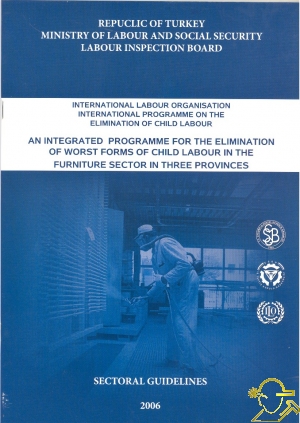An Integrated Programme for The Elimination of Worst Forms of Child Labour in the Furniture Sector in Three Provinces
İÇİNDEKİLERCHAPTER ONE: AN OVERVIEW OF THE SECTOR1.1 General Information 1.1.1 Occupational Branch 1.1.2 Occupational Code 1.1.3 Relevant Work and Workplace Regulations 1.1.4 Relevant Vocational Education Regulations 1.2. Sectoral Description 1.2.1. Workplace Descriptions 1.2.2. Woodworking Sector Workshops 1.2.3. Tools, Equipment, Machinery and Workbenches'. 1.2.4. Work Performed : CHAPTER TWO: DEFINITIONS, LABOUR LEGISLATION AND REGULATIONS GOVERNING CHILD AND YOUTH WORKERS 2.1 Definitions 2.2 Minimum Age and other Legislation Governing the Employment of Child and Youth Workers 2.2.1 Minimum Age for Employment 2.2.2 Work in the Furniture Sector in which Children and Youth Workers May Not Work 2.3 Fundamentals Governing the Employment of Apprentice, Child and Youth Workers 2.3.1 Points to be Observed in the Placement of Child and Youth Workers 2.3.2 Conditions for Apprenticeship 2.3.3 Conditions for Employment of Child and Youth Workers 2.3.4 Obligations of Employers 2.3.4.1 Employment Contracts and Certificates 2.3.4.2 Trainnig and other obligations CHAPTER THREE: WORKING CONDITIONS, WORKPLACE ENVIRONMENT, HAZARDS AND RISKS 3.1 Working Conditions 3.1.1 Work Organization 3.1.2 Working Hours 3.1.1.1 Work Breaks 3.1.2.2. Activities Considered as Time Spent at Work 3.1.2.3 Prohibition on Overtime Work 3.1.2.4 Prohibition on Working at Night 3.1.3 Payment 3.1.4 Weekly Time Off 3.1.5 National Holidays 3.1.6 Annual Paid Leave 3.2 Workplace Hazards and Risks 3.2.1 Building and Workshop 3.2.1.1 Building, Roof, Foundation, Flooring and Emergency 3.2.1.2. Placement of Workbenches and Machinery, Work Layout, Cleaning 3.2.1.3 Hazardous Areas 3.2.1.4 Guard Rails 3.2.1.5 Special Precautions to be Taken When Working Outside 3.2.1.6 Break Rooms and Rest Areas 3.2.1.7 Work Uniforms 3.2.1.8 Changing Rooms, Showers, Sinks and Toilets 3.2.1.9 Cafeteria Risks from Machinery, Workbenches, Pressure Vessels, Paintshops, Raw Materials and Finished Products Work Equipment Safety Issues Safety Features Precautionary Measures to be taken at Woodworking Workbenches Precautionary Measures for paint workshops Pressure Tanks Hazardous Material Electrical System Lifting Mechanisms Ambient Temperature Lighting Noise Dust/Ventilation Evacuation and Fire Drills Risk Appraisal and Health and Safety Information Risk Appraisal Material Safety Sheets Machinery Operating Instructions Warning Signs Individudal and Organizational Factors Health Reports Training and Supervision Training on Risks Personal Protective Equipment Work Assignments Inspection and Maintenance Teams Carrying Heavy Loads Incentive and Dissuasive Practices First Aid Registration and Certification Comparison of Costs of Workplace Accidents and Occupational Disease and Costs of Preventative Measures PTER FOUR: CONCLUSION NOTLARSectorial Guidelines   |



